By Tsegaye Tadesse
ADDIS ABABA, Nov 2 (Reuters) - Orthodox priests in
richly embroidered cloaks said a solemn requiem mass for
Ethiopia's late emperor Haile Selassie on Thursday, the 70th
anniversary of his coronation and three days before his
reburial.
Prayer services were held in all 70 Orthodox churches in the
capital Addis Ababa and hundreds of people attended the
mass in the imposing St Mary's Church where Selassie's
remains lie.
His coffin rested on a podium in a glass case, next to an
underground chamber housing the carved marble tombs of
four other members of Ethiopia's imperial family, including
the 19th Century Emperor Menelik II.
Princess Tenangne Work, Selassie's daughter, and scores of
his grandchildren and hundreds of royal supporters and
friends attended the requiem mass.
Selassie was crowned emperor of Ethiopia on November 2,
1930, and ruled with almost absolute power until he was
overthrown by Marxist military officers in 1974.
He died the following year, either killed by his captors or
simply denied the medical treatment that could have saved
him. His followers believe he was murdered.
"He was killed brutally because he was good man, as all
good men are killed," said the head priest celebrating the
mass.
An Ethiopian flag fluttered alongside the crown-topped spire
of St. Mary's Church as hundreds more people braved the
biting cold on the streets outside, including elderly
aristocrats with only memories left of the days under
Selassie's rule when they lived in plush villas.
The service was also attended by a Rastafarian delegation
from Trinidad and Tobago.
Rastafarians believe Haile Selassie to be a god. Those who
attended the mass were invited by his relatives, who are still
known as Ethiopia's royal family.
"We do not believe that he is dead. We communicate with
him in spirit daily," said Bernard David Rooks, leader of the
Rastafarian delegation. "Haile Selassie is very much alive."
Selassie's remains will be reburied in a private tomb in
Addis Ababa's Trinity Cathedral on Sunday.
The government, which toppled the Marxist government of
Mengistu Haile Mariam in 1991, attacked Selassie this
week as a tyrant who enslaved the peasants by imposing a
feudal system.
"Selassie's reign was marked by its brutality and extreme
oppression of the Ethiopian peasants," the government said
in a statement on Tuesday.
(C) Reuters Limited 2000.

03 Nov 2000 ETHIOPIA: Lion of Judah
controversial to the last.
By Tigist Belay in Addis Ababa and James Astill.
Over the last couple of weeks almost every aeroplane arriving
in Addis Ababa has carried either royalty, Rastafarians or
reporters. The sudden influx of interest in the city has little to do
with politics, economics or even a simple desire to visit
Ethiopia's capital.
For this Sunday, the Rastafarian religion's greatest symbol -
Emperor Haile Selassie - will finally be buried in his family's
tomb in Holy Trinity Church in Addis Ababa, and the great and
good are falling over themselves in their hurry to pay their
respects to the man considered by some to be the Messiah.
Yet not everyone buys into the myth. Amid all the preparations
for a glorious state funeral, the Ethiopian government this week
denounced Haile Selassie as `a despotic tyrant'. The prime
minister, Meles Zenawi, argued that the emperor presided over
a feudal oligarchy that reduced farmers to `tenants and serfs on
their own lands'.
Mr Meles accuses the emperor of upholding a system which
allowed the feudal class to lead a life of luxury at the expense of
the `toiling masses', while he amassed a huge personal fortune
and deposited it in foreign banks. The government is taking all
possible steps to retrieve these assets, he said.
The denunciation is the latest in a long-running feud between
the current Ethiopian government and Haile Selassie's family, a
feud which shows little sign of dissipating, even after the burial.
It is 70 years since Haile Selassie was crowned `Emperor of
Ethiopia, King of Kings, Lion of the Tribe of Judah, Elect of
God and Defender of the Faith', and 25 years since he died in
mysterious circumstances after a military coup.
His body was buried beneath a lavatory in the royal palace at
Addis Ababa and only discovered eight years ago, after the
collapse of Colonel Mengistu Haile Mariam's regime.
Since then the last emperor of Ethiopia's bones have remained
in a box marked `Do Not Touch' while the current government
argued with his descendants over what to do.
After two aborted attempts at a state burial, the remains have
been transferred to a narrow casket draped in a silver-threaded
shroud. From there, if all goes to plan, they will be moved to a
larger casket and Haile Selassie will be buried beside his wife in
the crypt of Holy Trinity church.
Yet controversy still rages over a man who, to many
Ethiopians, is not merely a symbol of long-gone royal power
but part of the oldest dynasty in the world, a ruler who claimed
direct descent from King Solomon and the Queen of Sheba.
Lionised by Rastafarians, who took his name - he was
originally called Ras Tafari - as the basis for their religion, Haile
Selassie was hailed by them as the Messiah and Ethiopia as the
promised land.
Nor was this worship confined to Africa. Haile Selassie's
charisma made him an early symbol of black pride. He was
recognised as the Messiah by the Jamaican-born US civil rights
leader Marcus Garvey and named Time Magazine's Man of the
Year in 1935.
His reputation grew from inauspicious beginnings.
Crowned in 1930, he had been Emperor for only six years
when Benito Mussolini's invasion of Ethiopia, then called
Abyssinia, forced him into exile in Bath. In June 1936 he
captured the world's imagination, eloquently pleading his cause,
and unsuccessfully for aid, at the League of Nations.
After Italy entered the second world war, help from the allies
enabled him to regain his throne, ruling Ethiopia until 1974.
Yet, behind the image of an independent African ruler lurked a
dirtier picture. For while Haile Selassie liked to think of himself
as an enlightened ruler - the benevolent father of his nation - the
reality was that the Lion of Judah lived in autocratic splendour,
ignoring both the crucial need for land reform and the poverty
of his people.
In 1974 he was deposed by the Marxist Colonel Mengistu
Haile Mariam, his immediate family were placed under arrest
and 11 months later Haile Selassie was said to have died of
natural causes.
Rumours persisted that he had been murdered and in February
1992, not long after Col Mengistu was himself overthrown by
the current leader of Ethiopia, previously silent eye witnesses
led digging crews to the ground under the Mengistu offices
where a set of bones, claimed to be the emperor's, were
discovered.
Yet even this has been disputed. The remains have never been
DNA tested and doubts about their authenticity remain;
meanwhile strict Rastafarians, who believe Haile Selassie did
not die but ascended into heaven, have denounced the
forthcoming burial as a fake.
Source: GUARDIAN 03/11/2000 P18
Thursday, November 2 9:50 PM SGT
Ethiopia pays tribute to Haile Selassie
ADDIS ABABA, Nov 2 (AFP) -
Members of Ethiopia's royal family, Christians and people who were close to the late emperor Haile Selassie flocked Thursday to churches here to pray for his soul, 70 years after he was crowned.
Hundreds of people gathered before daybreak at the Saint George and Trinity churches of the Ethiopian Orthodox faith in the capital Addis Ababa to pay tribute to the "King of Kings", who was overthrown in a 1974 military coup.
A group of 60 members of the royal family and more than 100 dignitaries and former aides went to the Taeka Negest Baata Mariam Geda church where the relics of the monarch have been kept since 1992, witnesses said.
Haile Selassie's eldest daughter, the octogenarian Princess Tenagnework, and his granddaughters, the princesses Aida, Seble and Sofia, and grandsons Haile Selassie and princes Zara Yacob Asfaw Wossen, Ermias Sahle Selassie, Beide Mariam Mekonen and Teferi were among those to attend the private Fethate Tselot mass of prayers for the soul and the forgiveness of sins.
Members of the family, who had arrived during the past fortnight from the United States, Canada and Europe, went into the imperial crypt during a ceremony that lasted for more than three hours, witnesses said.
"People were weeping, it was solemn but very emotional," a participant told AFP.
On Sunday, the remains of the former monarch, who was born on July 23, 1882, in the eastern Harar region, are to be transferred to the Trinity church in a state funeral ceremony starting at noon (0900 GMT).
The memorial events were sought by the royal family, who had asked the coalition government of the Ethiopian People's Revolutionary Democratic Front (EPRDF) to be allowed to proceed, and met with some opposition, according to local press reports.
Haile Selassie's foes reproach his 44-year reign of absolute power and a failure to change land policy or to make the government of his Horn of Africa country truly representative of the people, which is a patchwork of many different ethnic and religious groups.
Opponents also say Haile Selassie I, a name which means "power of the Trinity", refused to respond to protests by students and minority groups and did not act quickly to end the 1974 famine in Wollo in northeastern Ethiopia that killed 200,000 people.
However, the emperor, held to be the 225th descendant in the royal line of Menelik, son of King Solomon and the Queen of Sheba, also placed Addis Ababa on the map as an international capital, headquarters to the Organization of African Unity and the UN Economic Commission for Africa.
Seventy years ago, on November 2, 1930, the former Ras (Duke) Teferi Mekonen, was crowned emperor in full pomp and circumstance in Addis Ababa after he had already served as regent of the Abyssinian empire for 14 years.
The crowned heads of Belgium, Egypt, Italy, Japan, the Netherlands and the United Kingdom and the presidents of Germany and the United States were invited to the ceremony, where Haile Selassie, who had already been proclaimed Negus or king, was made the Negus Negast, seven months after the death of the Empress Zewditu.
Former French ambassador to Ethiopia Gontran de Juniac, author of Le Dernier Roi des Rois (The Last King of Kings), recalled that Britain and Italy respectively sent the Duke of Gloucester and Princess Udine, while France sent Marshal Franchet d'Esperey.
That coronation ceremony, which began during the night at the Cathedral of Saint George, saw his imperial majesty take the crown, sceptre and sword of Abyssinia and impressed the world.
Haile Selassie died, according to the official version, of a "failure of his blood circulation system" on the night of August 26, 1975, at the age of 82.
The belief persists, however, that he was murdered by the military regime of Mengistu Haile Mariam, who overthrew him the previous year, to be ousted in turn by rebel armies whose leaders are now Ethiopian Prime Minister Meles Zenawi and the president of independent Eritrea, formerly a province of Ethiopia.
SCENES FROM THE FUNERAL
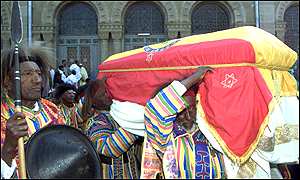
Veterans of the Ethio-Italian War (1936-1941) in Traditional warrior garb, with lion mane headdresses carry the coffin from the Ba'ita Mariam Monastery. The coffin is draped with the Emperor's personal standard, the Ethiopian tricolor with St. George Slaying the dragon on one side and the Lion of Judah on the other side.

The Coffin lies in state infront of Ba'eta Le Mariam Monastery Church where ceremonies are conducted in the presence of the Patriarch of the Orthodox Church and the Imperial Family.
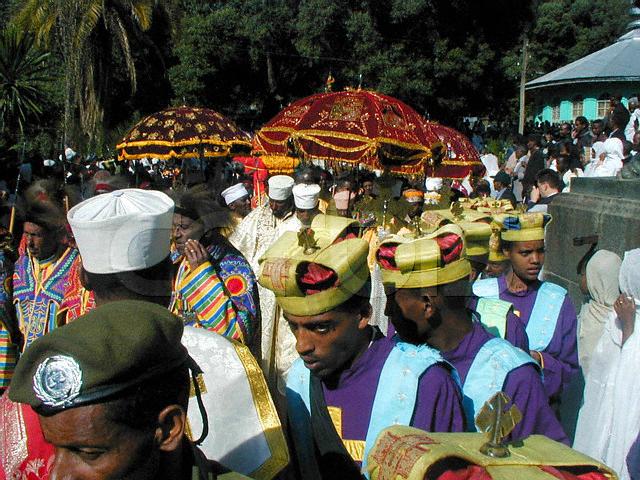
Clergy, and choir members begin the funeral procession out of the grounds of the Ba'eta Monastery as the public looks on.
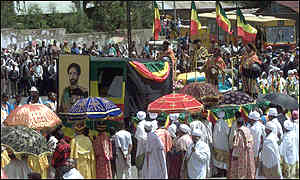
The coffin, on the bed of a draped flatbed truck, and a large portrait of His Late Majesty,winds it's way through the streets of Addis Ababa. Orthodox preists in glittering vestments, gold and silver sensers, processional crosses, drums, systrums and gold embroydered umbrellas mingle with the crowds.
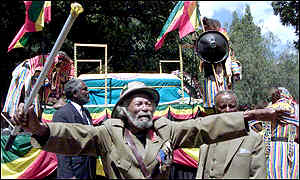
A veteran of the War against the Facist Italian invasion cries out his loyalty and devotion to the man who led him in war and peace, as the coffin passes in procession behind him.
 The Cortege winds it's way through the streets of Addis Ababa on it's way to Maskal Square
The Cortege winds it's way through the streets of Addis Ababa on it's way to Maskal Square
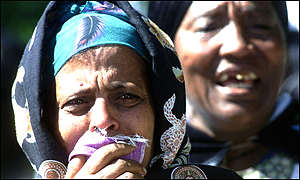 Many in the crowd were overcome with emotion at the sight of the Emperor's remains finaly recieving their due.
Many in the crowd were overcome with emotion at the sight of the Emperor's remains finaly recieving their due.
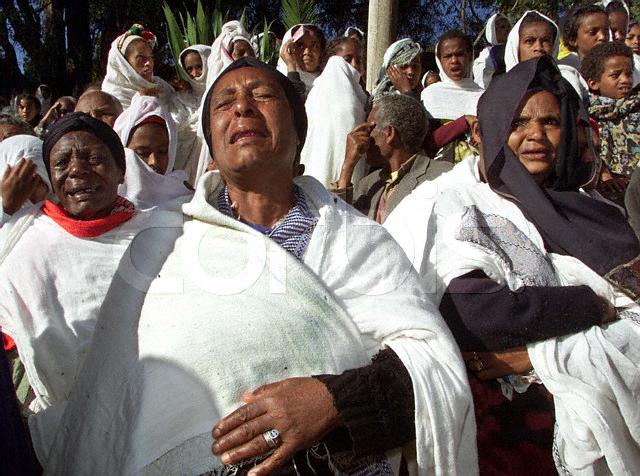 The funeral procession of the last Niguse Negest (King of Kings) was greeted everywhere with wailing and tears.
The funeral procession of the last Niguse Negest (King of Kings) was greeted everywhere with wailing and tears.
 A man holds up a picture of the late Emperor and Empress as he weeps
A man holds up a picture of the late Emperor and Empress as he weeps
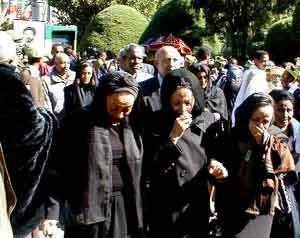 Once forbiden to weep for Haile Selassie I, women finally shed tears over his remains
Once forbiden to weep for Haile Selassie I, women finally shed tears over his remains
 A veteran of the Italo-Ethiopian War, wearing his medals, renders his Emperor homage by bringing his grandson to the funeral.
A veteran of the Italo-Ethiopian War, wearing his medals, renders his Emperor homage by bringing his grandson to the funeral.
 The Imperial Family watch the ceremonies at Maskal Square.
The Imperial Family watch the ceremonies at Maskal Square.
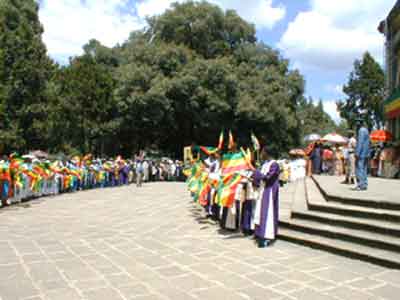 The cortege arrives at the Cathedral of St. George.
The cortege arrives at the Cathedral of St. George.
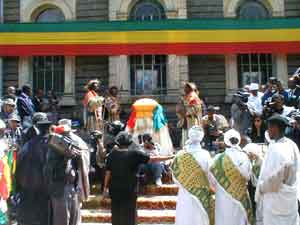 The remains lie in state at the Cathedral of St. George where the Emperor was crowned.
The remains lie in state at the Cathedral of St. George where the Emperor was crowned.
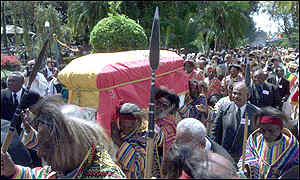
The coffin arrives at Holy Trinity Cathedral and is carried up the steps by war veterans amid a huge crowd of weeping and wailing former subjects.
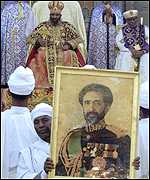
Abune Paulos, Patriarch of the Ethiopian Orthodox Church presides in the background surrounded by bishops and priests, as a clergyman holds a portrait of the Emperor over the coffin as a final service is conducted before the remains were carried into the Cathedral by the Emperor's grandsons, and laid in their final resting place.

Abune Paulos, Patriarch of Ethiopia, presides over the Funeral. To his right, seated, is His Imperial Highness Prince Zera Yacob Amha Selassie, son of the late Emperor in Exile Amha Selassie, and grandson of Emperor Haile Selassie.
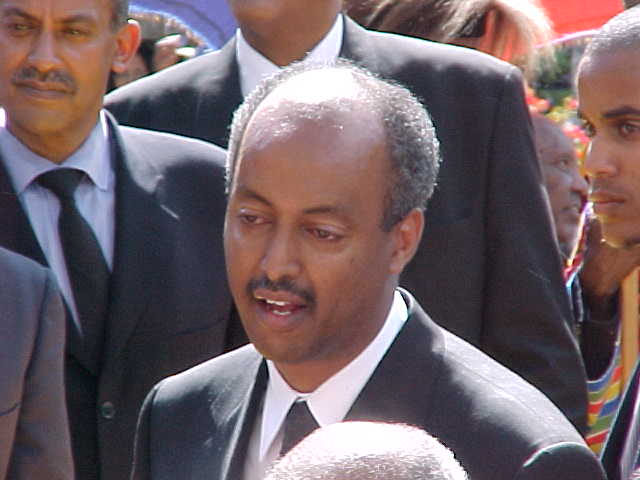
His Imperial Highness, Prince Beide Mariam Makonnen, son of the late Duke of Harrar, and grandson of Emperor Haile Selassie.
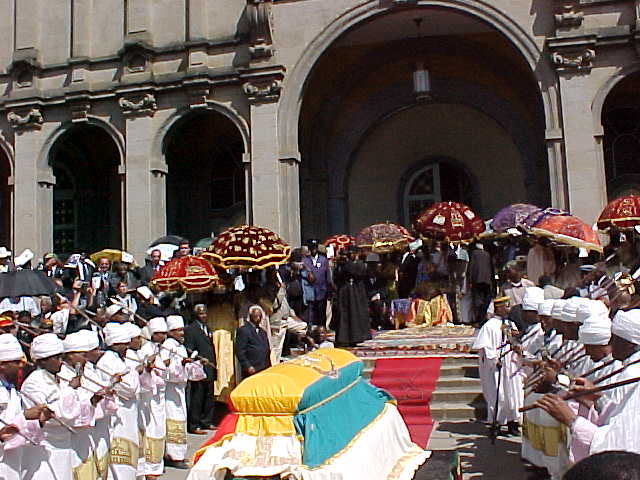
Clergy of the Orthodox Church sing and sway to the chants of St. Yared, acompanied by booming eclesiastic drums and silver cystrums, in a final service over the remains of the Emperor in front of Holy Trinity Cathedral
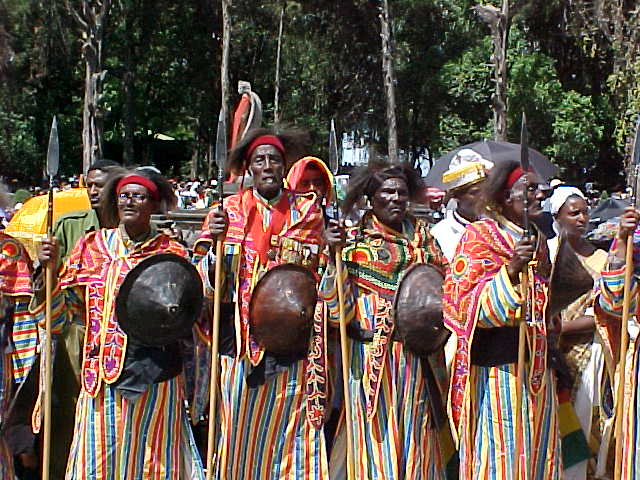 Aged War Veterans in Warrior Dress stand at attention at the funeral.
Aged War Veterans in Warrior Dress stand at attention at the funeral.
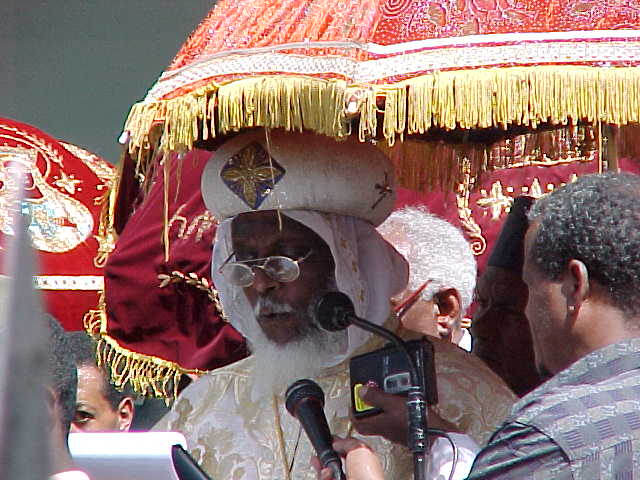
His Eminence, Archbishop Abune Gerima gives a speech in the name of the Holy Synod on the debt owed by the Ethiopian Orthodox Tewahido Church to His Late Majesty Emperor Haile Selassie I, King of Kings of Ethiopia.
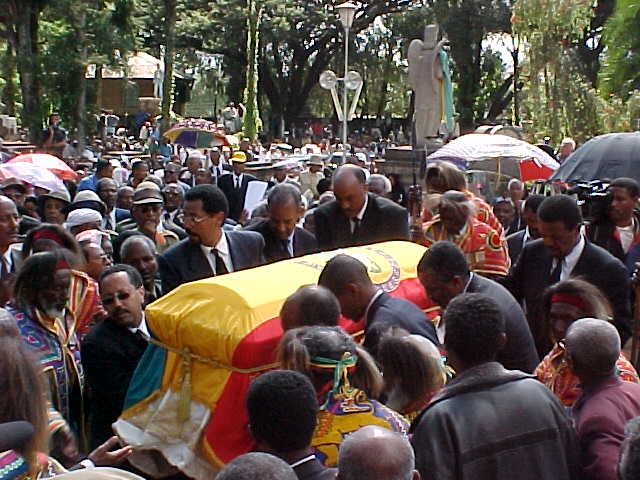
Princes of the Imperial House lift the coffin containing the earthly remains of the last Emperor of Ethiopia to carry them to their final rest.
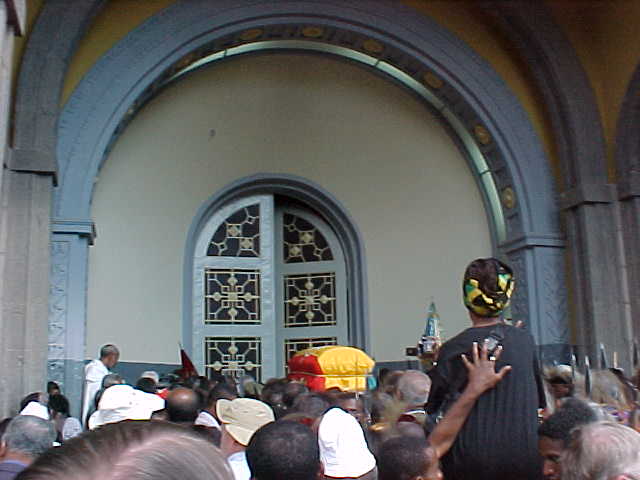 The coffin approaches the doors of Holy Trinity Cathedral
The coffin approaches the doors of Holy Trinity Cathedral
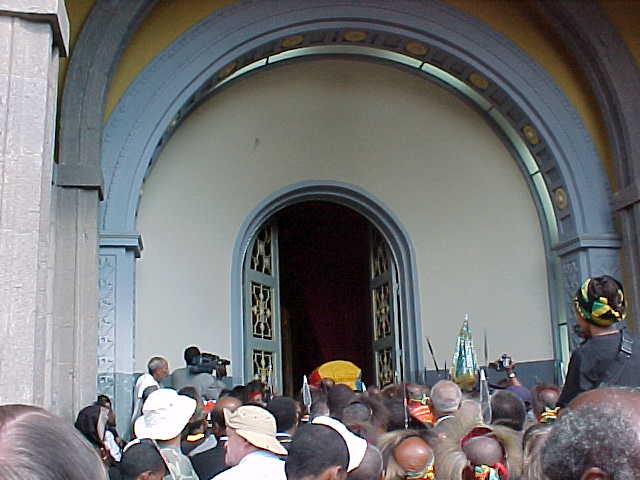
Emperor Haile Selassie I, Conquering Lion of the Tribe of Judah, Elect of God, King of Kings of Ethiopia finally goes into his place of eternal rest as church bells across Ethiopia toll a final and long overdue farewell.

The Emperor was entered in this granite sarcophagus in the north trancept of the cathedral, next to one containing the remans of his late wife, Empress Menen. This final internment was the only portion of the day's events that was personally witnessed by his aged only surviving daughter, Princess Tenagnework.
May God Grant Him Eternal Rest
And Seat Him on His Right Hand
With Abraham, Isaac, Jacob and David
and all Others of Blessed Memory who Have
Gone to Their Creator.
 Pictures and Stories on the Imperial Funeral Events
Pictures and Stories on the Imperial Funeral Events



 Pictures and Stories on the Imperial Funeral Events
Pictures and Stories on the Imperial Funeral Events


